

National Museum of Australia. Populate or perish When Japan entered the Second World War in December 1941 its troops quickly moved south, occupying much of South-East Asia and the Pacific.
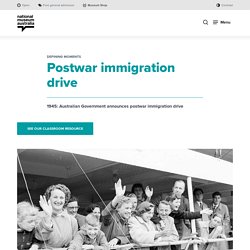
The Ten Pound Pom migration experience. Stephen Anstey: Coming to Australia was one of the best decisions my parents ever made.

My family came to Australia in May, 1968. We were assisted migrants from the United Kingdom, coming out on what is now known as the 10 Pound Pom scheme where families were assisted. Tasmania's history of immigrants and entrepreneurs. The forced migration of children to postwar Australia. The British migrants who were assisted were families and single men and women, so they are mainly adults, but of course the families had children.
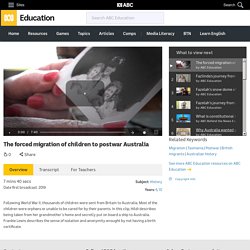
But there was a completely separate group and these were only children. Children without parents who were whose parents were killed during the war, or who were abandoned, and Australia was willing to take child migrants from Britain, assisting them out here, placed them with families where they could, if not they went into hostels. The Ten Pound Pom experience. They tell you all about these good things, I'll agree, but when you come out here, there's no good things at all.
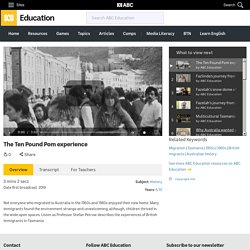
We were misled before we came here, told simply a pack of lies. Ten Pound Poms. Come over to the sunny side now.

Australia, a great place for families. Opportunity for you. Fine your wife. Kids News: Photos snapshot of post-war immigration during Ten Pound Pom White Australia scheme. More than 1.5 million people came to Australia from the UK after World War II as “Ten Pound Poms*” in what is one of history’s largest planned immigrations.
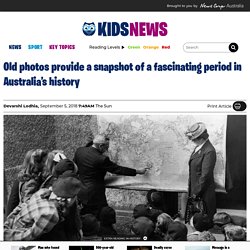
This collection of black-and-white photos provides a fascinating snapshot* of this period of history. Australia’s government, business owners and farmers wanted to increase the population, mostly so there were enough workers for all the jobs that needed doing. The people who came wanted to escape post-war food rationing* and housing shortages in the UK. Cities in the UK were heavily bombed during the war, so many houses were destroyed. UK farms didn’t produce enough food during and after the war as people were busy fighting or were killed, injured or making things needed for the war.
Packing for a voyage to a new country. Stephen Anstey: These are the items that my brothers and I bought or were given before we left England that we took onto the ship and we still have them.

So this is the leather school satchel, that was actually our school bag in England and in this, it was like our hand luggage. We put many of these things into this bag, carried them onto the ship. I was given some money before I got on the ship and for the first time I actually had the means to buy some items that I'd always wanted as a kid in England. Bonegilla - ABC Education. Benalla’s camp kids - ABC Education. Benalla Migrant Camp - ABC Education. Australia’s migration history. Australia’s migration history The nineteenth century In 1788, when European settlement began, Australia’s Aboriginal population was about 400,000.
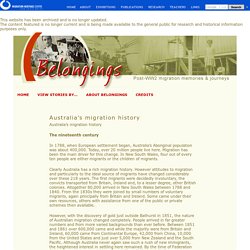
Today, over 20 million people live here. Migration has been the main driver for this change. In New South Wales, four out of every ten people are either migrants or the children of migrants. Clearly Australia has a rich migration history. However, with the discovery of gold just outside Bathurst in 1851, the nature of Australian migration changed completely. The infamous ‘White Australia’ policy: keeping Australia British. ABC online education - From Sudan to Adelaide. The changing face of modern Australia – 1950s to 1970s.
After the Second World War (1939–45) the Australian government committed to a vigorous and sustained immigration program.
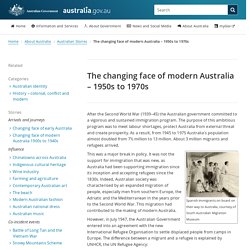
The purpose of this ambitious program was to meet labour shortages, protect Australia from external threat and create prosperity. As a result, from 1945 to 1975 Australia's population almost doubled from 7½ million to 13 million. About 3 million migrants and refugees arrived. Spanish immigrants on board on their way to Australia, courtesy of South Australian Migration Museum. HSIE stage3 - Home. A Dutch migrant in Lavington. Refugees and Migrants: 30/08/2016, Behind the News. Thousands of refugees have fled Syria over the past year.

Some of them have come to Australia. So next we're going to take a look at what a refugee actually is and how they're different to the thousands of migrants that come here to live too. MAHYA: It's really different in here, the foods are different, the people are different, all the things are different - even the shops! GEORGIA: I kind of just knew that it was a lot warmer than New Zealand! Which is why I was a bit nervous because I didn't actually know that much about it. Mahya and Georgia grew up worlds apart, but they share one life-changing experience - leaving everything they've ever known to come to Australia.
For 11 year-old Georgia, home used to be Auckland, New Zealand. African Migration: 31/07/2018, Behind the News. There have been news stories and many of our politicians commenting on some people who have migrated from Africa. So, we thought we'd give you a bit of background and find out some of the reasons why African people have moved here in the past. Meet Hussein. He loves soccer, playing video games, and hanging out with his friends. He was born in Kenya but moved to Australia with his family in 2009.